
Ipomopsis aggregata is a species of biennial flowering plant in the phlox family, Polemoniaceae, commonly known as scarlet trumpet, scarlet gilia, or skyrocket because of its scarlet red flowers with lobes curving back as if blown back by rocketing through the air.
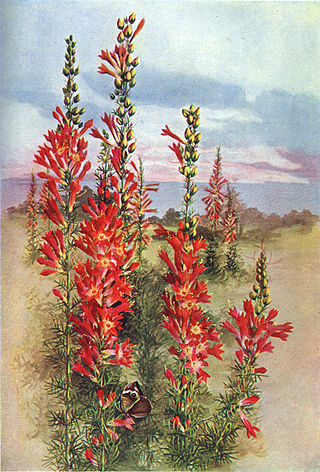
Ipomopsis is a genus of flowering plants in the phlox family, Polemoniaceae. The annual and perennial herbs it contains are native to the Americas, particularly North America.
Erysimum teretifolium is a species of Erysimum known by the common names Santa Cruz wallflower and Ben Lomond wallflower. It is a very rare plant endemic to Santa Cruz County, California, where it grows on inland sand spits, chaparral, and sandstone deposits in the southern Santa Cruz Mountains. It is a California state and federally listed endangered species.

Malacothamnus clementinus is a rare species of flowering plant in the mallow family known by the common name San Clemente Island bushmallow. It is endemic to San Clemente Island, one of the Channel Islands of California, where it is known from fewer than ten occurrences in the steep, rocky seaside canyons.

Asclepias welshii is a rare species of milkweed known by the common name Welsh's milkweed. It is native to southern Utah and northern Arizona, where there are four known occurrences remaining. Most of the plants occur in Coral Pink Sand Dunes State Park, where the habitat has been degraded in many areas by off-road vehicle use. It is a federally listed threatened species of the United States.
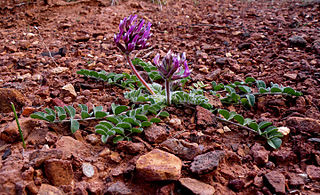
Astragalus holmgreniorum is a rare species of milkvetch known by the common names Holmgren milk-vetch and paradox milk-vetch. It is native to a tiny section of desert shrub woodland on the border between Utah and Arizona, in the far northern Mojave Desert. There are six populations remaining. It is a federally listed endangered species.

Carex lutea is a rare species of sedge known by the common names golden sedge and sulphur sedge. It is endemic to North Carolina, where it is known only from Pender and Onslow Counties in the Cape Fear River watershed. There are nine populations. The plant was discovered in 1991 and described to science as a new species in 1994, and it has not been thoroughly studied nor completely surveyed yet. Its rarity was obvious by 2002, however, when it was federally listed as an endangered species.

Carex specuicola is a rare species of sedge known by the common name Navajo sedge. It is native to a small section of the Colorado Plateau in the United States, its distribution straddling the border between Utah and Arizona, and completely within the Navajo Nation. There are several populations but they are limited to a specific type of habitat. The plants grow from the sides of steep, often vertical cliffs of red Navajo Sandstone, in areas where water trickles from the rock. It occurs at elevations between 5,700 and 6,000 feet, usually in shady spots. Though it is not a grass, the sedge grows in inconspicuous clumps resembling tufts of grass sticking out of the rock face. When the sedge was federally listed as a threatened species in 1985, it was known from only three populations in Coconino County, Arizona, with no more than 700 plants existing. The species has since been observed in northeastern Arizona and San Juan County, Utah.

Cirsium vinaceum is a rare species of thistle known by the common name Sacramento Mountains thistle. It is endemic to Otero County, New Mexico, in the United States, where it is known only from the Sacramento Mountains. The plant can be found in six canyon systems in a southern section of this mountain range spanning about 32 kilometers. It is rare because it is limited to a specific type of mountain wetland which is both naturally uncommon and threatened by a number of forces. The plant was federally listed as threatened in 1987.

Crotalaria avonensis is a rare species of flowering plant in the legume family known by the common names Avon Park rattlebox, Avon Park harebells, and Avon Park rabbit-bells. It is endemic to Central Florida in the United States, where it is known from only three sites. Many individuals exist on land that is unprotected and they are threatened with destruction. The plant is a federally listed endangered species.

Echinocereus fendleri is a species of cactus known by the common names pinkflower hedgehog cactus and Fendler's hedgehog cactus. It is named in honor of Augustus Fendler.
Exocarpos luteolus is a rare species of flowering plant in the sandalwood family known by the common names leafy ballart or heau. It is endemic to Hawaii, where it is known only from the island of Kauai. There are eight populations remaining, for a total global population of only 39 individuals. The plant was federally listed as an endangered species of the United States in 1994.

Hackelia venusta is a rare species of flowering plant in the borage family known by the common name showy stickseed, or lesser showy stickseed. It is endemic to Washington state in the United States, where it is known from only one canyon in Chelan County. There is only one small population with a global distribution of less than one hectare. The plant was federally listed as an endangered species of the United States in 2002.

Hedeoma todsenii is a rare species of flowering plant in the family Lamiaceae known by the common name Todsen's pennyroyal, or Todsen's false pennyroyal. It is endemic to New Mexico in the United States, where it occurs in the San Andres and Sacramento Mountains. It is federally listed as an endangered species of the United States.
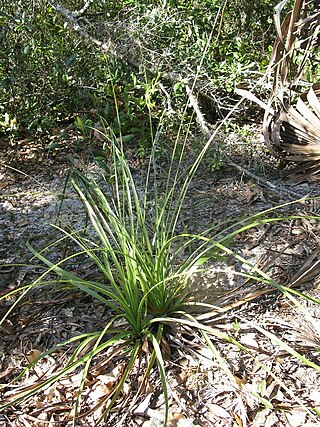
Nolina brittoniana is a rare species of flowering plant in the asparagus family known by the common name Britton's beargrass. It is endemic to Florida, where there are 72 known populations, only a few large enough to be considered viable. It is federally listed as an endangered species of the United States.
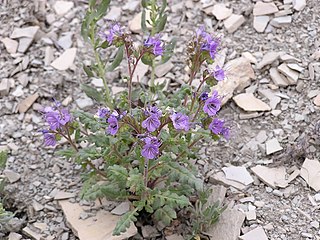
Phacelia argillacea is a rare species of flowering plant in the borage family known by the common names clay phacelia and Atwood's phacelia. It is endemic to Utah in the United States, where it is known only from one canyon in Utah County. It is "one of Utah's most endangered species"; it is "one of the nation's rarest plants" and is federally listed as an endangered species of the United States.

Remya kauaiensis is a rare species of flowering plant in the family Asteraceae, known by the common name of Kauai remya. It is endemic to Hawaii, where it is known only from the island of Kauai. It is threatened by the degradation of its habitat. It is a federally listed endangered species of the United States.
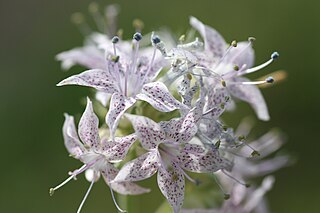
Ipomopsis polyantha is a rare species of flowering plant in the phlox family known by the common names Pagosa ipomopsis, Pagosa skyrocket and Archuleta County standing-cypress. It is endemic to Colorado in the United States, where it occurs only in the vicinity of Pagosa Springs in Archuleta County. It is threatened by the loss of its habitat to residential and commercial development. It was federally listed as an endangered species in 2011.

Phacelia submutica is a rare species of flowering plant in the borage family known by the common name De Beque phacelia. It is endemic to Colorado in the United States, where it is limited to the Piceance Basin in two counties. It is threatened by petroleum exploration. It was federally listed as a threatened species of the United States on July 27, 2011, a ruling which took effect on August 26, 2011.
Argemone pinnatisecta, known as the Sacramento prickly poppy, is an angiosperm and part of the poppy family. A very thorny looking perennial that grows up to a meter and a half in height. The thorny stems are covered in bluish green serrated leaves with spiky tips. The flower buds are also covered in these sharp thin thorns until they open, between May and August, revealing six white petals up to four centimeters long and nine centimeters wide, and a bright yellow anther with various stamens jetting out. The fruits of plant contain black seeds about two millimeters in diameter.


















